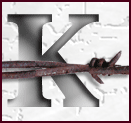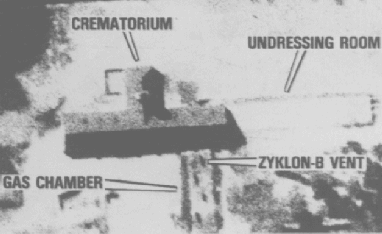



 Himmler inspected Auschwitz on March 1, 1941, and ordered that
a POW camp be built...Among other projects, the plan provided for
the construction of a crematorium capable of incinerating 1,440 bodies
in 24 hours. It was projected to consist of five three-retort ovens
for burning bodies, one oven for burning refuse, and one underground
mortuary. The site was to be in the main camp at Auschwitz.
Himmler inspected Auschwitz on March 1, 1941, and ordered that
a POW camp be built...Among other projects, the plan provided for
the construction of a crematorium capable of incinerating 1,440 bodies
in 24 hours. It was projected to consist of five three-retort ovens
for burning bodies, one oven for burning refuse, and one underground
mortuary. The site was to be in the main camp at Auschwitz.In consideration of the ongoing preparations for the extermination of Jews, it was decided to adapt the installation for mass killing by constructing a gas chamber next to it, in an underground facility also dedicated as a mortuary. The second room was to serve as a "dressing room". Both were to be ventilated mechanically.
An order placed with the firm Topf and Sons of Erfurt on October 22, 1941, stressed the urgency of the entire undertaking, demanding fast delivery: two weeks for technical drawings of the foundations and three months for parts of the ovens...However, before the construction work began, Heinz Kammler, chief of Group C of the SS Economic-Administrative Main Office and one of the closest associates of Himmler, arrived at Auschwitz on February 27, 1942 and ordered that the five-oven crematorium projected for Auschwitz be constructed at Birkenau.
Despite the hectic pace of work, which went on day and night, the approved deadlines for launching the crematoria failed to be met. The camp administration did not take delivery of the crematoria and gas chambers until the spring and summer of 1943...
A letter from the Zentralbauleitung to Group C of June 28, 1943 indicates that the capacity for a 24-hour period was estimated at 340 bodies for crematorium I; 1,440 each for crematoria II and III; and 768 each for crematoria IV and V. Thus the five crematoria could incinerate 4,765 bodies each day...
The furnace room occupied the largest interior space on the ground floor of the crematorium. It housed five furnaces, each with three retorts (about 2m long, 80 cm wide, and 1m high) that were used to push the bodies into the furnace. There were two generators of coke gas on the opposite side. The fumes were funneled to a single chimney through flues under the floor. Initially, the furnaces of crematorium II were equipped with a forced-draft installation. The draft was produced by three intake ventilators situated between the furnaces and the chimney. Within a short time, however, they burned out...
In addition, crematoria II and III were equipped with special furnaces for incinerating less-valuable articles, such as personal papers, women's purses, books, and toys that were found in the luggage of the murdered victims...The disinfected hair of gassed women was dried in the attic...
In the gas chamber's anteroom, the bodies were relieved of spectacles and artificial limbs, and the women's hair was cut off. Thereupon the corpses were loaded on the elevator platform and lifted to the ground floor. Some of the corpses were dragged directly to the oven area. Others were moved to the corpse storage room opposite the elevator, which also served as a site of executions by shooting. Just before incineration, Sonderkommando prisoners removed jewelry, which they tossed into a special numbered crate.
Teeth with metal fillings, crowns, and bridges made of gold or other precious metals were extracted from the mouths of the gassed victims and deposited in a crate marked "Zahnstation" (dental station)....
It took about four hours to empty the gas chamber. Initially, the corpses were delivered to the furnaces on small trolleys that ran on rails, as was done in the main camp. The trolleys also served to load the corpses into the furnace retorts. This arrangement, however, did not last long. On the initiative of the Kapo August Bruck, special corpse stretchers, which could be rolled into the retorts, were introduced. To facilitate the loading, the corpse stretchers were lubricated with soapy water. Methods of loading the corpses varied; each team servicing the furnaces had its own technique. For example, H. Tauber's team would put two corpses into one retort two times, then add as many children's corpses as possible to the second load.
It took about 20 minutes to cremate three corpses in one retort. However, in their efforts to reduce the number of loadings, prisoners cremated four to five corpses at one time, and extended the cremation time to about 25 to 30 minutes. When the time was up, the next load would be put into the retort, regardless of the degree of incineration of the preceding load. The incompletely incinerated bones fell through the grill into the ash pit, were ground with wooden mortars along with the ashes, then poured into pits near the crematorium. Next they were removed from the pits and poured into the Vistula river or nearby ponds. Sometimes they were used to prepare compost; other times they were used directly to fertilize the fields of the camp farms.
Anatomy, pp. 164-170.
Borowski, p. 49.
